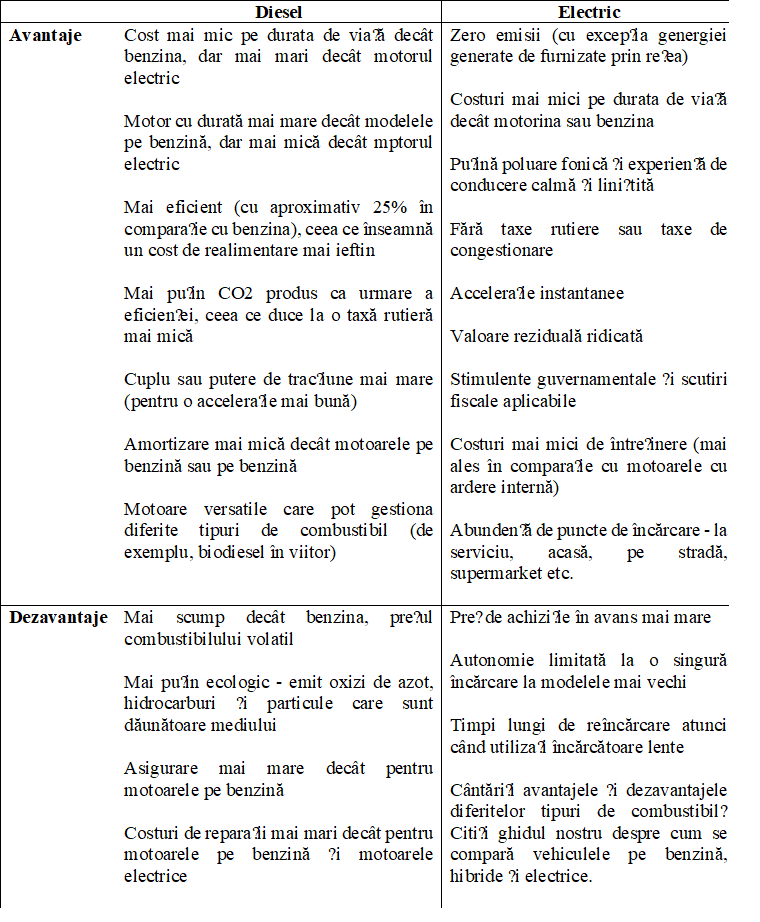
While diesel cars are cheaper to buy up front and have better torque, low running costs, less maintenance and fuel economy make electric cars a smart buy.
In a situation where there would be a sufficient number of charging stations, and if they were also high-power stations, an electric car is the car to pay attention to.

Purchase. The starting asking price for diesel and gasoline vehicles is often lower than for electric models due to the cost of EV batteries. Electric cars require a lot of expensive raw materials. The supply chain for electric vehicles is not as well developed as for fossil fuels.
In addition, electric vehicles have much more advanced technological systems as standard, as most manufacturers have only released one all-electric model. Unlike diesel cars, which can be cheaply mass-produced and have cheaper options, “with electric cars, you tend to put all your eggs in one basket.”
Prices for electric cars start at around 20,000 euros, for cars with a power equivalent to 80-150 hp and a minimum range of 150 km. Cars worth more than 50,000 euros are cars with a range of more than 300 km and high power. The Rabla Plus program, created specifically for electric cars, by awarding a voucher for 10,000 euros.
Looking at the retail prices of the petrol and electric Fiat 500, we see that the same car costs 136% more without the subsidy and 52% more with the subsidy.

Fuel consumption. To cover the same distance, an electric car needs 3 times less energy than a conventional car with an internal combustion engine.
In a well-to-wheel energy analysis, gasoline vehicles require the following steps: crude oil processing, delivery, engine conversion of fuel into mechanical energy.
The overall efficiency of this process is about 18-19%.
Stages related to an electric car include: production of electricity, transportation over the network, conversion of electrical energy stored in batteries into mechanical energy by the engine.
At the same time, the overall efficiency is about 52%.
Energy costs. Diesel fuel is the most expensive type of fuel to put in a car, due to high market demand, as well as higher taxes due to its perception of being “dirty”. Another reason is that diesel cars are declining in popularity as electric cars and efficient gasoline models with small engines continue to grow in popularity. Electric cars get a lot of praise for their low charging costs. This is largely due to the expansion of the charging infrastructure for electric vehicles and the wide availability of electricity. In some cases, you will be able to use a free top-up, which can be found at work or in the supermarket.
If you want to charge your electric vehicle at home, you will need to consider the cost of purchasing and installing a home car charger. It costs around 400 euros.
The table below shows models from the same popular brands and shows the difference in running costs between diesel, petrol, gas and electric models.

For those who want to compare fuel costs between different cars using the Classic – Electric Comparison Calculator
Maintenance. Traditional gasoline and diesel cars contain more than 100 moving parts. On the other hand, most electric cars have less than 5 moving parts in total, making them much easier and cheaper to maintain. Regenerative braking also helps reduce wear and tear on tires and braking systems.
In general, this means that the maintenance costs of an electric vehicle over its lifetime will be much lower than that of a conventional diesel or gasoline vehicle. The only downside at the moment is that services dedicated to electric cars are harder to find and require more effort to search

Time of life. The service life of an electric car is determined by the service life of the battery. Batteries for electric cars are built-in. Battery replacement does not make financial sense due to the cost of the battery and the labor involved in installing a new battery in many EVs.
One kWh for this car costs about 270 euros. Given that a €35,000 car has a 62kWh battery, the cost of the battery is €16,800.
The average value of autonomy indicated in the case of electric cars is about 300 kilometers. According to some studies, after six years of use, cars currently on the market have shown that they can still travel only 280 km on a full battery. However, many owners of these cars are very concerned about battery life. A recent study shows that 46% of electric car owners claim that the battery of such a car will last for a maximum of 100,000 km.
Currently, electric vehicle batteries sold in Europe have a warranty of 8 years or 150,000 km, some companies such as Kia or Hyundai give a longer battery warranty.
For example, Tesla representatives say that the Model S will lose only 5% of its original capacity in the first 80,000 km, and Tesla owners back up these claims by saying that they have only lost a few percent of their battery capacity after a few years of use. use.
Cars on classic fuel have a service life that allows them to reach 500,000 km. A diesel engine is twice or more durable than a gasoline engine. Because the compression ratio of diesel engines is higher, materials with greater strength are used to manufacture diesel engines.
Another feature of a diesel engine that provides a greater resource is power at maximum torque at low crankshaft speeds. A gasoline engine begins to pull well in the range of 3.5-4.5 thousand rpm, for a diesel engine, safe traction begins at 1.5 thousand rpm. The number of piston strokes is reduced, which means significantly less wear.
Impact on the environment. Data from the European Environment Agency show that diesel engines emit an average of 121.5 g/km of CO2. This is almost 1.5 times higher than the EU’s 2020-21 target for new cars of 95 g/km.
Electric vehicles produce higher emissions at the point of production.
Loading Charging an electric vehicle takes much longer than refueling at a gas station/diesel station, and it is also important to identify charging options in the common driving area. The time it takes to charge an electric car depends on where you choose to charge it. download This can take up to seven hours (charging at home overnight) or at best 30 minutes (quick charging at a public charging station). If you often travel long distances, an electric car is not a good choice.
insurance. Insurance of an electric car is on average approx. 20% less than fossil fuel cars.

Taxation. Electric cars are exempt from car taxes. Grammatically, “electric vehicles” also includes hybrid vehicles, but the car tax legislation only mentions a reduction in the amount of tax for this type of vehicle.
Efficiency. Electric powertrains have proven to be much more efficient than diesel engines because: EVs don’t suffer from idling fuel losses like diesels, most EVs have what’s called “regenerative braking” in which energy is collected by the electric motor as it slows down and then delivered as an additional battery charge and, unlike diesel cars, there is no risk of wasting energy due to inefficient gear shifting. These machines have a single speed and provide instant torque when accelerating.
Driving style. An electric car offers a different experience than a classic car. A distinctive feature of an electric car is the instant torque that the electric motor develops when you press the gas pedal. It provides instant power transfer and acceleration to the wheels. Increasing speed in a conventional vehicle requires gradual shifting through a series of gears.
The car in cold weather. Romanian winters can affect the autonomy of an electric car, as below minus 5 degrees it starts to create certain problems. Up to this threshold, the changes are reasonable: the consumption is higher, but not twice as much, less time for the battery to heat up, a change in the temperature in the car (air conditioner) by 1-2 degrees plus or minus.
With a fully charged battery, you can get about 170 km of autonomy in the case of the BMW i3 with a large battery (94 A·h, 33 kWh) in temperatures of no more than -5 degrees Celsius. When the temperature drops to -12 degrees Celsius, the range can reach 140 km or less. The main disadvantages of an electric car in winter: the shorter the distances, the higher the consumption, thermal comfort in the car affects autonomy, the battery is difficult to heat up and cool down. Interior heating has a big impact on electricity consumption, so to offer an alternative, most are equipped with heated seats and steering wheels.
What should you pay attention to when buying an electric car?
Battery capacity: corresponds to the equivalent of the tank capacity of a car with an internal combustion engine and is indicated in kWh.
Autonomy: depends on battery capacity. Range also varies depending on various factors including: personal driving style, road conditions, outside temperature, heating/air conditioning and preheating.
Maximum capacity of the on-board charger: The capacity of the battery charger is determined by the voltage, which can be 230 V (single-phase) or 400 V (three-phase) and the charging current (eg 10 A, 16 A , 24 A , 32 A, etc.) and ranges from 2.3 kW (slow charging via cable with internal connector) to 50 kW (fast charging in cm3). This determines how quickly the battery can be charged.
Vehicle charging cable: Each vehicle is compatible with one or two types of charging cables that come with the purchase or lease of the vehicle. They can be used at public charging stations or at home
N. Ed: Dumitru Kiselice is the president of the Intellectual Energy Association

Source: Hot News
Ashley Bailey is a talented author and journalist known for her writing on trending topics. Currently working at 247 news reel, she brings readers fresh perspectives on current issues. With her well-researched and thought-provoking articles, she captures the zeitgeist and stays ahead of the latest trends. Ashley’s writing is a must-read for anyone interested in staying up-to-date with the latest developments.